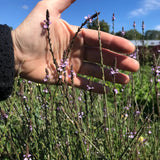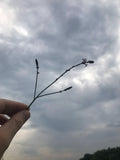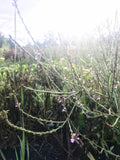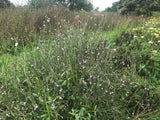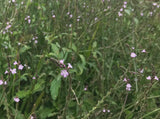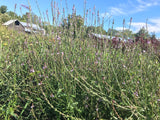European Vervain
Verbena officinalis
European vervain is an unassuming perennial herb, delicate but mighty. Under the right conditions it can become a dense, groundcover-like herb. The wispy purple flower spikes make a lovely addition to complete any medicinal garden.
In ancient Celtic culture, European vervain was one of the druids' most sacred plants. They considered vervain a magic plant, and would use it to prophesy. It was believed to protect the garden and those who tended to or surrounded it. It used to grow commonly in the wild in the UK, but now it is quite rare. Herbalists then and now use vervain in a number of ways. It is astringent, anti-inflammatory, antispasmodic, antibiotic, and antiviral. It is employed to lift one’s mood, or as a gentle sedative. It also stimulates production of progesterone, increases milk flow in lactating mothers, and supports PMT and menopause. The flowering tops and leaves can be dried, tinctured, or made into an infusion. It is a gentle herb, but should not be taken when pregnant.
Also known as Common Vervain, Common Verbena, Herb of the Cross, Prostrate Verbena, Simpler’s Joy, and Holy Herb.
Days to maturity: Perennial
Seeds per pack: 125-150
Germination rate: 57% (total viability: 79%) on 01/28/2025 (read more about viability)
Planting / harvesting notes
Growing notes: European vervain seeds require 2 weeks of cold stratification before sowing, which can be accomplished by sowing in a cold, damp early spring soil, or refrigerated in cold, moist soil before sowing indoors. Sow on the surface of the soil, barely covering but tamping down. Transplant with 1.5 foot spacing.
Seed keeping notes
Seed harvest timing is a bit tricky; the harvest window is short. Harvest when the seeds are mature but before they jump or fall off the plant and get lost. Therefore, it’s best to harvest when the seeds on the top half on the spike are dry. Cut the stems and allow the seeds to dry down on the stems for a few weeks before shaking all the seeds off and collecting them.







